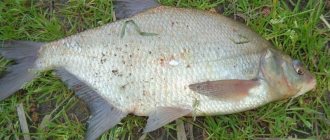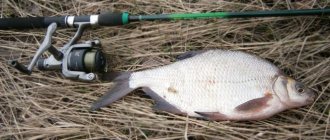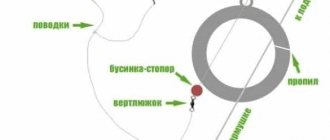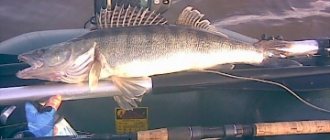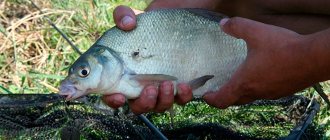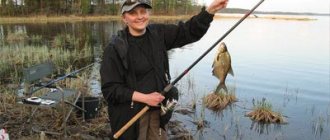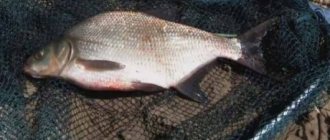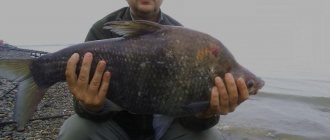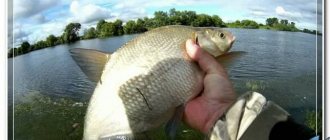Bream from a boat onto a float rod
Nothing makes float fishing more successful than having a boat! The main problem with a float rod is the inability to cast it to a good depth from the shore. This leads to the fact that anglers take fishing rods of enormous length, bulky and heavy. Even if they are made of good material, they are still not as convenient as a small rod for catching small fish.
The situation is slightly corrected by using match rods and rods with a reel. But they are not always good for fishing from the shore. Even with a match fishing rod, it is comfortable to fish at a distance of no more than 30-40 meters, let alone a lapdog that is not intended for long casts! A boat in the current allows you to sail from the shore to where schools of bream are moving. You can fish both in the current and in still water, and move in a timely manner if there is no bite. You can use a feeder with a float so you can see where to cast, and take it to the fishing spot on a boat.
Victoria Leshchenko
I've been working hard in the fishing tackle department for the past six years. I can help you assemble almost any gear.
Ask a Question
The boat is also good when fishing in line. From it you can increase the wiring distance, because in this case the float will not relate to the shore, and you can lead the tackle in one line with the rod. In this case, you can bring the bait to the expected fish site from a greater distance, without scaring it away with a boat or the presence of an angler, and catch one bream after another without scaring off the entire flock.
At great depths in the fall, you can fish with a sliding float, registering bites better than with alarms when bottom fishing. A sliding float with a jig gives good results. Fishing is carried out from a boat, which is rafted downwind or very slowly with oars, or even anchored. The jig twitches from time to time, attracting fish, but the line itself remains weakened until the float. This allows you to compensate for the excitement and shaking of the stern of the boat and is more effective than fishing with a regular jig, which on the boat will twitch chaotically after it. The jig itself is about 20-30 millimeters long, including the hook, and is quite heavy.
Tips for choosing bait for bream
Spring baits
Depending on weather conditions in the spring, bream can actively react to different baits: March: bloodworm, worm, semolina, dough. April worm, maggot, bloodworm. May peas, corn, dough, pasta, semolina, bread, boiled wheat, pearl barley. The higher the air and water temperatures, the faster the bream switches from animal baits to plant baits.
Summer baits
In the summer heat, many complain about a complete lack of bite, but this is not always true. Properly selected bait can attract the attention of bream even in the heat. June: worm, maggot, corn, peas, pasta. July: steamed barley, maggot worms in the form of sandwiches. August: bread, pasta, corn, maggot worm. Temporary decreases in temperature indicators will entail a return of bream to animal types of bait ; vegetable bait should be offered in hot weather.
Autumn lures
In the autumn, bream continue to be actively caught on the feeder; groundbait and bait, as before, should work in tandem in such gear. As the temperature drops, bream will again want “meat” baits. September: earthworm and dung worm, maggot, hominy, bread, steamed cereals. October: bloodworms, worms, less often maggots. November: maggots and bloodworms, plant-based baits will not work. It is important to understand that the bait used in crushed form must be added to the bait .
Winter lures
In winter, bait for bream is very important; it is more difficult for passive fish to attract attention. Therefore, the selection of bait should be approached very carefully. December : sandwiches made from pieces of worms, bloodworms and maggots, less often boiled peas are used. January : bloodworm, worm. February : worm, bloodworm, semolina, peas. You can experiment and try using the dough as bait; at the end of February, bream can respond well to this species.
Tackle
Despite the limited space on the boat, fishing can be done with completely different gear, the choice of which is determined by the fishing conditions and the preferences of the fisherman. First of all, the differences in gear depend on how strong the current in the reservoir is.
Float rod
In reservoirs with no current and shallow depths, it is best to fish for bream using a regular float rod. It is built on a shortened Bolognese rod 3–4 meters long; longer forms are very inconvenient to use in a boat. Naturally, in this case the forms are equipped with spinning reels for ease of casting and retrieving fish.
The boat will help you fish with a float rod even where it is impossible to fish from the shore due to growing grass or bushes.
The float is equipped with running or blind equipment. The choice depends on the depth at the fishing spot, but most often they choose gear with a sliding float; it is this design that allows you to fish at great depths, exceeding the length of the fishing rod itself.
The equipment sequence is as follows:
- A monofilament line with a diameter of 0.18–0.22 millimeters is wound onto the reel.
- Install a plastic or silicone stopper to limit the height movement of the float. Some amateurs knit a simple stop knot.
- A sliding float is put on the fishing line.
- A second lower stop is installed, which protects the float from contact with the weights.
- Install several weights, spreading them along the height of the descent.
- Attach a leash with a hook. The choice of leash depends on the size of the intended trophy, most often from 0.10 to 0.14 millimeters. The hook is selected according to the bait used.
Float fishing is carried out with preliminary feeding and throwing feeding balls to a point. It is desirable that bream always have the opportunity to rummage in the bottom silt, looking for tasty aromatic crumbs.
Attention! The first to come to the bait are usually nimble roaches or silver breams. You can cut them off using larger volume nozzles.
Such a voluminous bait is only suitable for large fish.
Feeder
Fishing for bream on a feeder from a boat is characterized by the use of shortened rods - pickers. Otherwise, fishing with this gear is completely identical to its coastal counterpart.
A boat feeder is used when it is impossible to reach a fishing spot from the shore due to an increased distance or difficult coastal conditions:
- dense thickets of vegetation;
- waterlogging;
- steep bank.
The picker is equipped with a spinning reel equipped with a monofilament (0.22–0.25 mm) or braid (0.12–0.16 mm). In the second case, it is desirable to use a nylon shock leader.
Depending on personal preferences, feeder installation is used. For catching bream, the following options are most preferable and more sensitive:
- inline;
- asymmetrical loop for flow;
- asymmetrical loop for standing water.
Inline is the only rig used in fishing competitions.
Feeders and sinkers are used depending on the fishing conditions and the chosen feeding tactics. The only condition is the ability of the load to hold the equipment at the fishing point under the influence of the current.
Bream on the ring
Catching bream with a ring is an ancient method that was used by people back in the times of Aksakov and Sabaneev. It was bream that was the target object of such fishing, and we can confidently say that in the current this is the best way. In the old days, they caught fish this way during the spawning run, and the catch per day from a boat was comparable to the catch from fishing with a net. Nowadays, catching bream during the spawning period is prohibited, but this in no way reduces the effectiveness of ring fishing compared to other methods of catching bream. It is used throughout the CIS - from the Western Dvina and Volga to Kamchatka and Amur.
Fishing is very similar to bottom fishing. In this case, the feeder sinks to the bottom, tied to a string. The feeder is filled with various cereals, steamed rice, millet, stale bread, and ready-made dry bait. The main thing is that they are washed out of it well in water. The string is threaded through a ring weight that moves freely up and down along it. The main fishing line and a stake with hooks are tied to the ring; their number is the same as when fishing with a can. The fisherman lowers the ring to the bottom towards the feeder, while the hooks straighten with the flow. After the ring reaches the bottom, it is very important to loosen the feeder line a little so that you can see the bite on it too.
When biting, the angler slightly pulls the ring up, then throws a couple of loops of the feeder line down and makes a hook. The fish usually don’t keep you waiting, and there are times when a large school approaches the feeder, and the angler pulls out two or three bream at once! Ring fishing is so productive and exciting that many people cannot stop and exceed the catch limits, which is a violation of fishing rules.
Modern ring fishing uses onboard fishing rods with a reel, and instead of the ring, so-called “eggs” are placed - two lead weights with a diameter of about 15 millimeters, attached to a spring, squeezing them together. This allows you not to loosen the bowstring of the feeder before hooking, since the weight of the “egg” flies off it during a jerk and does not interfere with landing the fish. A number of other improvements are also being applied.
Influence of current and features of fishing from a boat
You must remain quiet at the fishing site, as noise can scare the fish. It is better to fish a little downstream from the bait site. You need to find a space where there are no snags, because the bream tries to avoid them, as there may be pikes in them.
You need to start fishing in the morning and first throw in a few handfuls of bait. It is added a little every half hour.
The bite is expressed in different ways: sharp jerks or slow trembling. There is no need to rush into hooking; everything must be done smoothly. During the current, this fish can resist quite strongly.
Catching bream from a boat is a very exciting activity. If you correctly fulfill all the requirements, then your fishing can be crowned with success, and you will end up with a huge and tasty trophy on the hook.
What are the advantages of catching bream on a donk?
The advantages of bottom gear when fishing for bream are due to the feeding habits of this fish, which seeks food in the bottom layers and will certainly respond to a correctly presented, attractive bait.
The caution of bream forces the fisherman to use thin fishing lines, high-quality hooks and a variety of baits when fishing, but biting a large fish becomes a worthy reward for perseverance and attention to detail.
In the coastal zone, it is not a problem to catch bream and float rigs are used for this, but trophy bream are caught only with bottom gear, at a considerable distance from the shore. This fish is found in almost all inland waters and anglers have the opportunity to regularly practice catching it, improving their skills.
Fishing technique and tactics
When catching bream with eggs, a leash with attached hooks is lowered into the water simultaneously with the feeder. The general tactic of such fishing is that the current washes out the contents of the bait box and carries it in the same direction as the leash, creating a kind of feeding path. Attracted by the aroma of the delicacy, the fish approaches the fishing spot where the baited hook is located. The bream swallows the bait and gets caught by the fishing rod, and the fisherman pulls the catch out of the water
To achieve a good result, it is also important to follow the technique of catching bream with eggs.
You will be interested to know how to catch bream at night.
From the boat
By boat, a fisherman can get directly to the habitat of bream, finding it using the signs listed above. In order not to scare away the fish, it is recommended to use only oars when approaching the desired section of the reservoir, turning off the engine.
The technique of catching fish with eggs in this case consists of the following actions:
- Stop the boat, positioning it sideways to the current.
- Slowly lower the anchor into the water. If there is gusty wind outside or there is a strong current, then two anchors are used for fixation.
- Collect tackle. Fill the feeder about halfway with bait.
- Slowly lower the feeder to the bottom using the cord, leaving it slightly taut. The product must stand steadily and not lie on its side.
- Pass the free end of the cord through the eggs so that it passes between the two balls, and then tie it to the boat. Bait the hooks.
- Lower the tackle into the water, smoothly moving it in a vertical direction.
- Periodically move the tip of the rod so that the line is slightly stretched and loosened - this will help attract bream faster.
Important! You can quickly find a promising fishing spot in an unfamiliar body of water using an echo sounder. It makes it possible to obtain information about the bottom topography and determine the most likely habitats of bream
From the shore
Fishing eggs can only be used in bodies of water with a current. In standing water, the contents of the feeder are not washed out, so the tackle does not work. Near the shore, the depth is usually shallow and there is practically no current, so fishing eggs are used mainly for fishing from a boat.
But if there are artificial structures on the shore that protrude far into the water and have a steep slope, you can catch bream using eggs from them. A prerequisite for using gear in such circumstances is a sufficient depth of the reservoir in the selected area - at least 4 m. The technique of such fishing is similar to that used when fishing from a boat.
Fishing eggs can significantly help in catching bream, but only if they are installed correctly and the equipment is used correctly. The information presented in the article will allow you to independently install the equipment, and recommendations for choosing bait and groundbait will help you fish more profitably, increasing your chances of attracting many large fish.
Fishing
The winter experience of fishing for bream, with hand-pulling the line, is largely in demand when onboard fishing, where I fish in the same way, putting the rod aside after hooking. Yet there are two differences in this matter. The first is pleasant, due to the fact that when the bream is brought to the boat, in the water, all its movements are visible in the palm of your hand. In winter, especially if the ice is cloudy or covered with snow, I only see bream lips, and then only when I have already brought the fish into the hole, and before that everything is done by touch. The second feature of fishing is that the process is more complex than in winter. In open water, problems with large bream often arise when I bring them to the upper layers of the water. He often starts playing in circles and goes under the boat. It can pretend to be completely exhausted, but as soon as you start to bring it into the landing net, the bream turns around and powerfully tears to the side or down. And so, it happens, he mocks him two or three times until he ends up in the landing net. Of course, it would be useful to tire the fish somewhere closer to the bottom, but it will scare away the whole school there. And immediately after hooking, a side fishing rod cannot, due to its design, move it away from the baited area, as a float rod or feeder can do. And at any stage of fishing I can’t force it, because in winter and summer I fish with a fairly thin line of 0.12 mm (real diameter), which usually gives more bites, and they are more confident, compared to thicker equipment.
Best fishing spots
They say that bream points for fishing with onboard tackle often coincide with winter ones, and then ice experience is a great help when searching for fish in open water. Things work out a little differently for me. In winter, the main bream depths where I fish are no more than 5-5.5 m. But in open water I fish in completely different areas, although the depths are almost the same. This is an almost flat plateau, there are just regular drops of ten centimeters up and down. The bottom is soft, the anchor is covered in a black mess, there is no grass. That is, a vast, uniform area along which the bream most likely moves widely, and there is no need to find a point that worked well before on the next fishing trip. But where can you not return to where the bream pleased you with the bite last weekend! Therefore, I enter a place into the navigator and stand on the stretchers approximately in the same place where I fished earlier. Although it is quite problematic to become absolutely perfect, especially in the wind - by the time you figure out the stretch marks, you will be wrong by 3-4 meters.
Time of day
Compared to winter, the daily fishing period is quite short. In winter, I often fish at night, and even during the short winter day there are periodic outbreaks of biting. In general, you can feed the point, relax and, having gone out for the night, calmly wait for the fish to approach. With onboard gear, fishing is more dynamic, often only taking place in the morning hours.
The first bites for me usually begin an hour and a half after dawn - until you feed, until everything on the bottom settles down, until the fish approaches and the main peak of the bite begins. Something else may continue to hatch, but after 10 o’clock there was never much bite, and I sit until lunch at the most.
Onboard fishing rod
An onboard fishing rod for summer fishing from a boat is a relative of winter gear for catching, say, pike perch.
This is a short rod, consisting of a handle with a reel, a hook, 50-70 cm long, depending on the height of the side of the boat and a nod, the rigidity of which depends on the weight of the equipment, the strength of the current and the expected weather, i.e. the height of the waves on the reservoir today. The swinging of the rod (nod) from the excitement of the reservoir should be filtered by the fisherman's gaze from real fish bites. The hook of the rod should be moderately hard in order to be able to hook a fairly heavy fish, but not tear the weak lips of the bream.
The size of the reel should be sufficient to wind the amount of fishing line corresponding to the diameter, depending on the depth of the reservoir. In reservoirs, bream fishing depths can be, depending on weather conditions, 22, 14, or 6 meters. When choosing the diameter of the fishing line, you should be guided by the following:
- a fishing line that is too thin will get tangled in the boat when fishing, especially if a wave washes into the boat;
- a fishing line that is too thick will have a large windage and will bend with the current, which will complicate hooking the fish due to the large slack;
- The optimal thickness of the main line when fishing in a reservoir should be considered a line with a diameter of 0.25-0.28 mm.
Special mention should be made about the thoughtfulness of attaching the fishing rod in the boat, since accidental solutions to this issue cause a lot of trouble after, for example, the blow of the “ninth shaft”, or the careless movement of a fisherman in the boat. All of the above applies most of all to fishing from an inflatable boat.
The majority of fishermen fish from an “elastic band” - an inflatable boat. When fishing in large bodies of water, it is preferable to have a two-section boat with an inflatable bottom. The carrying capacity of such a vessel is 200-260 kg. This boat has three independent inflatable compartments - two onboard and an inflatable bottom. To catch bream, the boat must be installed correctly
All of the above applies most of all to fishing from an inflatable boat. The majority of fishermen fish from an “elastic band” - an inflatable boat. When fishing in large bodies of water, it is preferable to have a two-section boat with an inflatable bottom. The carrying capacity of such a vessel is 200-260 kg. This boat has three independent inflatable compartments - two onboard and an inflatable bottom. To catch bream, the boat must be positioned correctly.
Installation of the boat on a body of water with current is carried out using anchor guy wires. A synthetic rope with a diameter of 6-8 mm and a length of 100-150 m with anchors is used as a stretch. In everyday life, anchors are ordinary railway linings on the rails. Large for large bodies of water with strong currents, small for rivers. The installation process looks like this:
- We determine our parking spot.
- We move out half the length of the rope perpendicular to the current and throw the first anchor.
- We select a landmark on the other bank and row in the direction where the second anchor will be thrown, so that the stretch line is perpendicular to the current. Not right away, but it will work out.
- When the rope ends, we throw a second anchor. The rope must be in your hands at all times, otherwise you will lose it.
- Moving your hands along the rope, you move with the boat until the middle of the stretch, where you tied a knot in advance.
- You tie the boat to the guy line and you are ready to fish.
If the bottom of the reservoir where the anchors are sunk is muddy, you will not have any problems with fixing the anchor to the bottom. The silt instantly sucks in the anchor and the boat is firmly anchored.
It’s another matter if the bottom is sandy or rocky. In a strong current, the anchor can drag along the bottom, which will result in the boat “running over” the feeder. To prevent this, you can hammer a couple of wooden stakes into the lining so that the anchor scratches along the bottom and “claws” at something.

